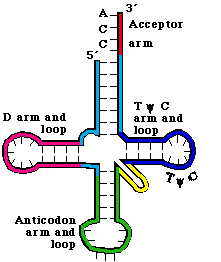 |
The sequence of the MHL1 gene is used to create a complimentary
strand of messenger RNA (mRNA). The RNA carries the same base pair sequence
as the coding DNA. However, the messenger RNA strand is processed to make
it ready for protein synthesis. Chunks of mRNA called introns are removed
from the strand because their sequences to not pertain to the code needed
to build the peptide chain.
Once the mRNA is processed it exists the nucleus at attaches
to a ribosome. At the same time transfer RNA (tRNA) attaches to amino acids.
The structure of a transfer RNA molecule is shown here. The green, anticodon
arm contains 3 key nucleotides that will match up with the codons on the
mRNA strand in the ribosome. The acceptor arm at the top of the tRNA is
where amino acids attach. Each of the 20 amino acids can only attach to
the tRNAs that will bind to their specific codon on the mRNA strand. |